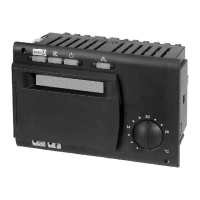120/218
Siemens Building Technologies Basic Documentation RVA63.242, RVA53.242 CE1P2373E
Landis & Staefa Division Description of heating engineer settings 26.03.2001
4.56 D.h.w. priority
Optimum distribution of heat.
Setting range Unit Factory setting
0...3 Increment 1
During d.h.w. heating, space heating will be restricted, depending on the setting made.
0 Absolute priority
Mixing and pump heating circuit remain locked until the d.h.w. is heated up, the
system pump remains activated.
1 Shifting priority
If the capacity of the heat source is no longer sufficient, mixing and pump
heating circuit will be restricted until the d.h.w. is heated up.
2 No priority
D.h.w. heating and space heating at the same time.
In the case of tightly sized boilers and mixing heating circuits, the setpoint may
not be reached if the heating load is great, since too much heat is required for
space heating.
3 Mixing heating circuit shifting, pump heating circuit absolute
The pump heating circuits remain locked until the d.h.w. storage tank is heated
up. If the capacity of the heat source is no longer sufficient, the mixing heating
circuits will also be restricted.
4.56.1 Frost protection for the plant
Frost protection for the plant is fully active only in the case of setting 2. With setting 0 or
1, it will be partly or fully restricted. If the boiler is correctly sized, frost protection for the
plant is also ensured when using setting 1. In the case of plants where there is a
considerable risk of frost (e.g. plants with outdoor heating), setting 0 should not be
used.
4.56.2 Shifting priority
The purpose of this function is to achieve optimum d.h.w. heating and, at the same
time, to deliver superfluous heat to the heating circuits. This means that during d.h.w.
heating, the actual value of the boiler temperature should be as close as possible to the
boiler temperature setpoint without shutting down the burner. To achieve this, it may be
necessary to restrict the heating circuits by means of a locking signal. This locking
signal is generated with the help of a temperature-time integral.
Depending on the consumer, the locking signal will lead to switching on / off or a
setpoint reduction.
Benefit
Setting
Effect

